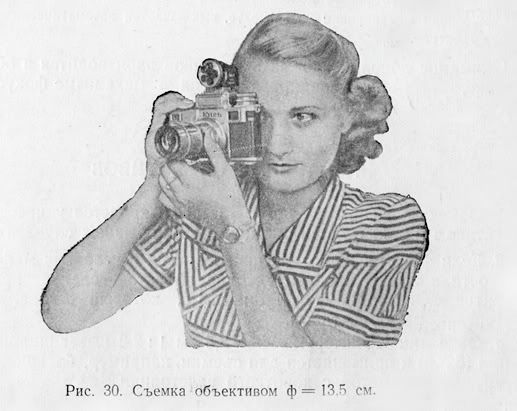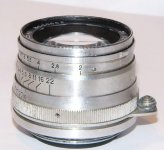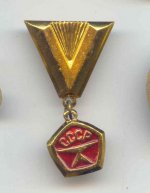dexdog
Veteran
Any opinions as to whether this purported 50/2 Zonnar Krasnogorsk in LTM is legitimate, or a fake? eBay auction 350190980848. Looks old and beat up, but I am wondering whether the engraving on the front ring looks OK. I am pretty sure that the very early ZKs had the 19-rhombus-48 dating system, but don't have any FSU reference books to look it up. In any case, don't feel like gambling the $200 blindly to get a $50 Jupiter. Nothing against the Jupiters, but I could find one in LTM a lot cheaper than this one.
xayraa33
rangefinder user and fancier
Any opinions as to whether this purported 50/2 Zonnar Krasnogorsk in LTM is legitimate, or a fake? eBay auction 350190980848. Looks old and beat up, but I am wondering whether the engraving on the front ring looks OK. I am pretty sure that the very early ZKs had the 19-rhombus-48 dating system, but don't have any FSU reference books to look it up. In any case, don't feel like gambling the $200 blindly to get a $50 Jupiter. Nothing against the Jupiters, but I could find one in LTM a lot cheaper than this one.
it looks like a j-8 with a different beauty ring.
there is no way to tell other than taking it apart.
for a bit more to that price , i would rather buy a 5cm f2 nikkor in screw mount.
nicer build, no guess game, and it holds its price.
dexdog
Veteran
Already have a nikkor 50/2 that came attached a Nicca 3F that cost 200 usd. Interested in a ZK mostly as a curiousity
No way to tell unless you buy it and take it apart. And even after that, it can be hard to tell.
Some odd 5cm f1.5 Zeiss Jena lenses here:
http://www.ziforums.com/showthread.php?t=224
I've never taken apart a ZK lens, but have taken apart J-8's and CZJ SOnnars. The rear modules are similar, but the front section of the Zeiss lens is much different. The front element and the front group are in brass mounts, and are stamped with the serial number of thelens.
Some odd 5cm f1.5 Zeiss Jena lenses here:
http://www.ziforums.com/showthread.php?t=224
I've never taken apart a ZK lens, but have taken apart J-8's and CZJ SOnnars. The rear modules are similar, but the front section of the Zeiss lens is much different. The front element and the front group are in brass mounts, and are stamped with the serial number of thelens.
Last edited:
dexdog
Veteran
Brian, you sonnar posts on ZIforum is one of the reasons that these old lenses intrigue me. Can't blame this on Dante Stella
I know... I want a ZK 5cm F1.5 just to take it apart.
I just got back a roll from a 1953 KMZ J-3. It is as good as the Wartime CZJ 5cm F1.5 Sonnar. I'm told that German glass was used on the early J-3's, which would explain a lot! It was fun to take apart- it had two sets of taps for the set screws and two red dots for the Aperture index. I ended up resetting the helical in the mount back to the "unused" set.
I just got back a roll from a 1953 KMZ J-3. It is as good as the Wartime CZJ 5cm F1.5 Sonnar. I'm told that German glass was used on the early J-3's, which would explain a lot! It was fun to take apart- it had two sets of taps for the set screws and two red dots for the Aperture index. I ended up resetting the helical in the mount back to the "unused" set.
xoDox
Member
This one is fake - I am 100% sure. Although, it's a good one  .
.
First, the majority of ginuine ZK 5cm/2 were made collapsible and only a few rigid.
Second, the so-called ears on the aperture ring are tiny here! Most likely, the original aperture ring grip was filed down to make up the ears, but still you can see the step (the leftover from the old grip)- so this job was not done very accurately.
Third (and most important), on the ZK the aperture numbers are engraved in line with the ears (see the right picture of ginuine ZK).
Lastly, I've never heard that ZKs have a "holder" (have no idea of the better word for the thing that stands apart from the lens housing - on the bottom right of picture), but J-8 from the early 50's have it.
I can't speak about bubbles - you need to see the lens. Aslo, coating has a special cast on ZKs and it's different from later J-8.
Unfortunately, I don't have ZK 5cm/2, but I made quite a research on this subject, so you may be sure. The picture of the ginuine ZK 5cm/2 aperture ring is taken from http://www.dvdtechcameras.com/collect/arsenal/1/k6.htm . The LTM (Zorki) version has exactly the same design of the aperture ring, but I couldn't find a ZK picture of such quality.
Most likely J-8 from the early 50-s was used here to reproduce ZK 5cm/2. I think it's optics is good, but it should be placed in another price category.
Word of warning: don't trust the engravings on the front ring they can be easily faked with the moder equipment.
First, the majority of ginuine ZK 5cm/2 were made collapsible and only a few rigid.
Second, the so-called ears on the aperture ring are tiny here! Most likely, the original aperture ring grip was filed down to make up the ears, but still you can see the step (the leftover from the old grip)- so this job was not done very accurately.
Third (and most important), on the ZK the aperture numbers are engraved in line with the ears (see the right picture of ginuine ZK).
Lastly, I've never heard that ZKs have a "holder" (have no idea of the better word for the thing that stands apart from the lens housing - on the bottom right of picture), but J-8 from the early 50's have it.
I can't speak about bubbles - you need to see the lens. Aslo, coating has a special cast on ZKs and it's different from later J-8.
Unfortunately, I don't have ZK 5cm/2, but I made quite a research on this subject, so you may be sure. The picture of the ginuine ZK 5cm/2 aperture ring is taken from http://www.dvdtechcameras.com/collect/arsenal/1/k6.htm . The LTM (Zorki) version has exactly the same design of the aperture ring, but I couldn't find a ZK picture of such quality.
Most likely J-8 from the early 50-s was used here to reproduce ZK 5cm/2. I think it's optics is good, but it should be placed in another price category.
Word of warning: don't trust the engravings on the front ring they can be easily faked with the moder equipment.
Any opinions as to whether this purported 50/2 Zonnar Krasnogorsk in LTM is legitimate, or a fake? eBay auction 350190980848. Looks old and beat up, but I am wondering whether the engraving on the front ring looks OK. I am pretty sure that the very early ZKs had the 19-rhombus-48 dating system, but don't have any FSU reference books to look it up. In any case, don't feel like gambling the $200 blindly to get a $50 Jupiter. Nothing against the Jupiters, but I could find one in LTM a lot cheaper than this one.
Attachments
Paul T.
Veteran
Great post!
I should have known all of that, having studied Zks in the past, and owning one in Contax mount. But I didn't.
I hereby award you the honorable certificate of the Kneb floozy...

I should have known all of that, having studied Zks in the past, and owning one in Contax mount. But I didn't.
I hereby award you the honorable certificate of the Kneb floozy...

xoDox
Member
Thanks for award, ha-ha! I was thinking about something like a quality sign of the USSR!!!
BTW, I 've had exactly this "faked" ZK in my own hands recently. It had a very rough step (from the lathe work) on the aperture ring. The ears were "rudimentary" not like ZK. Overall the lens was quite good for J-8, but obviously it wasn't a ZK. On the coating side, it didn't have any on the front, but the rare element almost "shined" with a very strong coating. It puzzled me for some time... The answer may be simple: the fraud artists could have removed the coating from the front element considering its look more important. An uncoated element gives them some proof that the lens is ginuine from the 40s, but this is false. As we know Sonnar optics came to USSR coated.
Besides, the coating cast of this lens was much different from the typical Jena Sonnar and ZK. I assume, there was a change in coating procedure in the beginning of 50's at Zorki plant and they started to make multi-coated optics.
BTW, I 've had exactly this "faked" ZK in my own hands recently. It had a very rough step (from the lathe work) on the aperture ring. The ears were "rudimentary" not like ZK. Overall the lens was quite good for J-8, but obviously it wasn't a ZK. On the coating side, it didn't have any on the front, but the rare element almost "shined" with a very strong coating. It puzzled me for some time... The answer may be simple: the fraud artists could have removed the coating from the front element considering its look more important. An uncoated element gives them some proof that the lens is ginuine from the 40s, but this is false. As we know Sonnar optics came to USSR coated.
Besides, the coating cast of this lens was much different from the typical Jena Sonnar and ZK. I assume, there was a change in coating procedure in the beginning of 50's at Zorki plant and they started to make multi-coated optics.
Attachments
The German Sonnars were coated from about 1939 and on. All of the F1.5 and F2 5cm Sonnars that I've seen from wartime cameras are coated. I've seen some post-war adaptations of Zeiss Sonnar lenses to LTM as uncoated.
All of the surfaces of the FSU lenses were coated, and the color could vary. They were not multi-coated. That practice started to become common in the late 60s with the Japanese manufacturers. No one -to my knowledge- did it with commercial optics in the 50s.
The Russians had a lot of "spare parts" brought back after the war. I suspect that a lot of these were made into one-off's, some for practice, some for personal use. I've seen such lenses with a mix of coated and uncoated optics.
ALSO: the '53 J-3 that I have is very close to the Zeiss lenses in rendition. Higher contrast and a tad sharper than my later 1950s J-3.
All of the surfaces of the FSU lenses were coated, and the color could vary. They were not multi-coated. That practice started to become common in the late 60s with the Japanese manufacturers. No one -to my knowledge- did it with commercial optics in the 50s.
The Russians had a lot of "spare parts" brought back after the war. I suspect that a lot of these were made into one-off's, some for practice, some for personal use. I've seen such lenses with a mix of coated and uncoated optics.
ALSO: the '53 J-3 that I have is very close to the Zeiss lenses in rendition. Higher contrast and a tad sharper than my later 1950s J-3.
Last edited:
Share:
-
This site uses cookies to help personalise content, tailor your experience and to keep you logged in if you register.
By continuing to use this site, you are consenting to our use of cookies.



